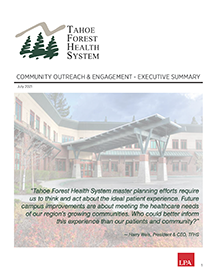Overview
Food insecurity is defined at the household level as limited or uncertain access to adequate food. Adults facing food insecurity may be at higher risk for obesity and chronic diseases. Children affected by food insecurity are also at risk for obesity, may experience developmental delays and may have trouble in school. A reduced frequency, quality, variety, and quantity of food can negatively impact children’s mental health. Contributing factors to food insecurity include income, employment status, disability, race or ethnicity, physical access to food, and lack of transportation.
Goal
Reduce the proportion of socioeconomically disadvantaged community members experiencing food insecurity from the baseline of 14% (2021) to the Healthy People 2030 target of 6% by June 30, 2029.
Target Population
Socioeconomically disadvantaged community members
Food Insecurity (defined as “worried about running out of food any time in the past year”) chart description: Chart compares data from 2021 and 2025 between randomly survey adults and socioeconomically disadvantaged community members. The chart shows that 14% of socioeconomically disadvantaged adults experience food insecurity, as compared to 3% of randomly surveyed adults in 2021. In 2025, 44.6% of socioeconomically disadvantaged adults experience food insecurity, as compared to 10.7% of randomly surveyed adults. The HP 2030 target for socioeconomically disadvantaged adults experiencing food insecurity is 6% and improvement is for metrics to trend downward.

* SED – Socioeconomically Disadvantaged
Coming soon
Coming soon
Coming soon
- Socioeconomically disadvantaged – means living in less favorable social and economic circumstance than others in the same community. For example, it could be not having enough money to meet basic needs, such as rent, food, medicine and transport, or it could be not having access to the same education opportunities or literacy as other people. The disadvantage results from one or more of the following circumstances: poverty, source of income, illiteracy, level of education, address, type of housing or homelessness, employment status or any other similar circumstance.
- Healthy People 2030 (HP2030) sets data-drive national objectives to improve health and well-being over the next decade. HP2030 objective – reduce household food insecurity and hunger – NWS-01.


